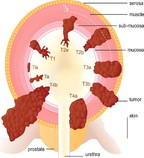
Bladder Cancer
In the United States, bladder cancer is the fourth most common type of cancer in men and the ninth most common cancer in women. More than 50,000 men and 16,000 women are diagnosed with bladder cancer each year. Smoking can only partially explain this higher incidence in men. One other reason is that the androgen receptor, which is much more active in men than in women, plays a major part in the development of the cancer.
Bladder cancer is any of several types of malignancy arising from the epithelial lining (i.e. "the urothelium") of the urinary bladder. The bladder is rarely involved by non-epithelial cancers (such as lymphoma or sarcoma) but these are not properly included in the colloquial term "bladder cancer." It is a disease in which abnormal cells multiply without control in the bladder. The bladder is a hollow, muscular organ that stores urine; it is located in the pelvis. The most common type of bladder cancer recapitulates the normal histology of the urothelium and is known as transitional cell carcinoma. It is estimated that there are 383,000 Bladder cancer cases worldwide.
Signs and symptoms
Bladder cancer characteristically causes blood in the urine; this may be visible to the naked eye (gross hematuria) or detectable only by microscope (microscopic hematuria). Other possible symptoms include pain during urination, frequent urination (polyuria), or feeling the need to urinate without results. These signs and symptoms are not specific to bladder cancer, and are also caused by non-cancerous conditions, including prostate infections and cystitis. Kidney cancer also can cause hematuria.
Causes
Tobacco smoking is the main known contributor to urinary bladder cancer; in most populations, smoking is associated with over half of bladder cancer cases in men and one-third of cases among women. There is a linear relationship between smoking and risk, and quitting smoking reduces the risk. Passive smoking has not been proven to be involved. In a 10-year study involving almost 48,000 men, researchers found that men who drank 1.5L of water a day had a significantly reduced incidence of bladder cancer when compared with men who drank less than 240mL (around 1 cup) per day. The authors proposed that bladder cancer might partly be caused by the bladder directly contacting carcinogens that are excreted in urine, although this has not yet been confirmed in other studies. Thirty percent of bladder tumors probably result from occupational exposure in the workplace to carcinogens such as benzidine. 2-Naphthylamine, which is found in cigarette smoke, has also been shown to increase bladder cancer risk. Occupations at risk are bus drivers, rubber workers, motor mechanics, leather (including shoe) workers, blacksmiths, machine setters, and mechanics. Hairdressers are thought to be at risk as well because of their frequent exposure to permanent hair dyes. A 2008 study commissioned by the World Health Organisation concluded that "specific fruit and vegetables may act to reduce the risk of bladder cancer." Fruit and yellow-orange vegetables, particularly carrots and selenium, are probably associated with a moderately reduced risk of bladder cancer. Citrus fruits and cruciferous vegetables were also identified as having a possibly protective effect.
It has been suggested that mutations at HRAS, KRAS2, RB1, and FGFR3 may be associated in some cases.
Diagnosis
Bladder tumor in FDG PET due to the high physiological FDG-concentration in the bladder, furosemide was supplied together with 200 MBq FDG. The uptake cranial to the lesion is a physiological uptake in the colon.
Many patients with a history, signs, and symptoms suspicious for bladder cancer are referred to a urologist or other physician trained in cystoscopy, a procedure in which a flexible tube bearing a camera and various instruments is introduced into the bladder through the urethra. Suspicious lesions may be biopsied and sent for pathologic analysis.[citation needed]
The gold standard for diagnosing bladder cancer is biopsy obtained during cystoscopy. Sometimes it is an incidental finding during cystoscopy. Urine cytology can be obtained in voided urine or at the time of the cystoscopy ("bladder washing"). Cytology is very specific (a positive result is highly indicative of bladder cancer) but suffers from low sensitivity (inability of a negative result to reliably exclude bladder cancer). There are newer non-invasive urine bound markers available as aids in the diagnosis of bladder cancer, including human complement factor H-related protein, high-molecular-weight carcinoembryonic antigen, and nuclear matrix protein 22 (NMP22). NMP22 is also available as a prescription home test. Other non-invasive urine based tests include the CertNDx Bladder Cancer Assay, which combines FGFR3 mutation detection with protein and DNA methylation markers to detect cancers across stage and grade, and the UroVysion test.
The diagnosing of bladder cancer can also be done with a Cysview guided fluorescence cystoscopy, as an adjunct to conventional white-light cystoscopy. This procedure improves the detection of bladder cancer and reduces the rate of early tumour recurrence, compared with white-light cystoscopy alone. Cysview cystoscopy detects more cancer and reduce recurrency. Cysview is marketed in Europe under the brand name Hexvix
However, visual detection in any form listed above, is not sufficient for establishing pathological classification, cell type or the stage of the present tumor. A so called cold cup biopsy during an ordinary cystoscopy (rigid or flexible) will not be sufficient for patological staging either. Hence, a visual detection needs to be followed by transurethral surgery. The procedure is called transurethral resection TUR. Further, bimanual examination should be carried out before and after the TUR to assess whether there is a palpable mass or if the tumour is fixed ("tethered") to the pelvic wall. The pathological classification obtained by the TUR-procedure, is of fundamental importance for making the appropriate choice of ensuing treatment and/or follow-up routines.
Pathological classification
90% of bladder cancers are transitional cell carcinoma. The other 10% are squamous cell carcinoma, adenocarcinoma, sarcoma, small cell carcinoma, and secondary deposits from cancers elsewhere in the body.
Carcinoma in situ (CIS) invariably consists of cytologically high grade tumour cells.
Staging
T (Primary tumour)
- TX Primary tumour cannot be assessed
- T0 No evidence of primary tumour
- Ta Non-invasive papillary carcinoma
- Tis Carcinoma in situ (‘flat tumour’)
- T1 Tumour invades subepithelial connective tissue
- T2a Tumour invades superficial muscle (inner half)
- T2b Tumour invades deep muscle (outer half)
- T3 Tumour invades perivesical tissue:
- T3a Microscopically
- T3b Macroscopically (extravesical mass)
- T4a Tumour invades prostate, uterus or vagina
- T4b Tumour invades pelvic wall or abdominal wall
N (Lymph nodes)
- NX Regional lymph nodes cannot be assessed
- N0 No regional lymph node metastasis
- N1 Metastasis in a single lymph node 2 cm or less in greatest dimension
- N2 Metastasis in a single lymph node more than 2 cm but not more than 5 cm in greatest dimension,or multiple lymph nodes, none more than 5 cm in greatest dimension
- N3 Metastasis in a lymph node more than 5 cm in greatest dimension
M (Distant metastasis)
- MX Distant metastasis cannot be assessed
- M0 No distant metastasis
- M1 Distant metastasis.
Screening
As of 2010 there is insufficient evidence to determine if screening for bladder cancer in people without symptoms is effective or not.
Treatment
Flow chart of the Bladder Cancer Treatment Guide
The treatment of bladder cancer depends on how deep the tumor invades into the bladder wall. Superficial tumors (those not entering the muscle layer) can be "shaved off" using an electrocautery device attached to a cystoscope, which in that case is called a resectoscope. The procedure is called transurethral resection - TUR - and serves primarily for pathological staging. In case of non-muscle invasive bladder cancer the TUR is initself the treatment, but in case of muscle invasive cancer, the procedure is insufficient for final treatment. Immunotherapy in the form of BCG instillation is also used to treat and prevent the recurrence of superficial tumors.
BCG immunotherapy is effective in up to 2/3 of the cases at this stage. Instillations of chemotherapy, such as valrubicin (Valstar) into the bladder can also be used to treat BCG-refractory CIS disease when cystectomy is not an option. Urocidin is phase III trials for this.
Patients whose tumors recurred after treatment with BCG are more difficult to treat. Many physicians recommend Cystectomy for these patients. This recommendation is in accordance with the official guidelines of the European Association of Urologists (EAU) and the American Urological Association (AUA). However, many patients refuse to undergo this life changing operation, and prefer to try novel conservative treatment options before opting to this last radical resort. Device assisted chemotherapy is one such group of novel technologies used to treat superficial bladder cancer. These technologies use different mechanisms to facilitate the absorption and action of a chemotherapy drug instilled directly into the bladder. Another technology uses an electrical current to enhance drug absorption. Another technology, thermotherapy, uses radio-frequency energy to directly heat the bladder wall, which together with chemotherapy shows a synergistic effect, enhancing each other's capacity to kill tumor cells. This technology was studied by different investigators.
Untreated, superficial tumors may gradually begin to infiltrate the muscular wall of the bladder. Tumors that infiltrate the bladder require more radical surgery where part or all of the bladder is removed (a cystectomy) and the urinary stream is diverted into an isolated bowel loop (called an ileal conduit or Urostomy). In some cases, skilled surgeons can create a substitute bladder (aka neobladder) from a segment of intestinal tissue, but this largely depends upon patient preference, age of patient, renal function, and the site of the disease.
A combination of radiation and chemotherapy can also be used to treat invasive disease. It has not yet been determined how the effectiveness of this form of treatment compares to that of radical ablative surgery.
Photodynamic diagnosis may improve surgical outcome on bladder cancer.











